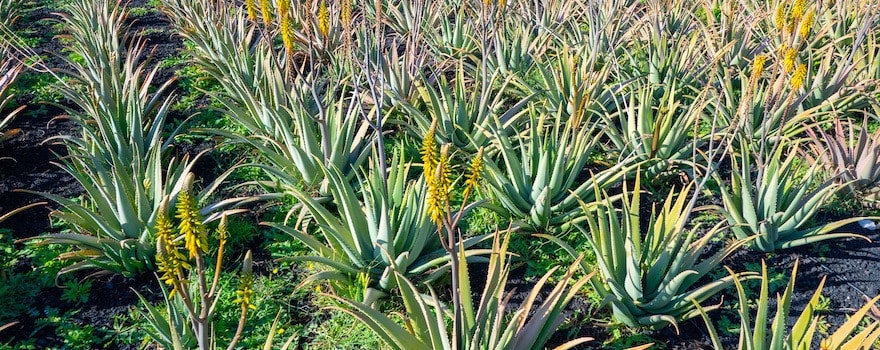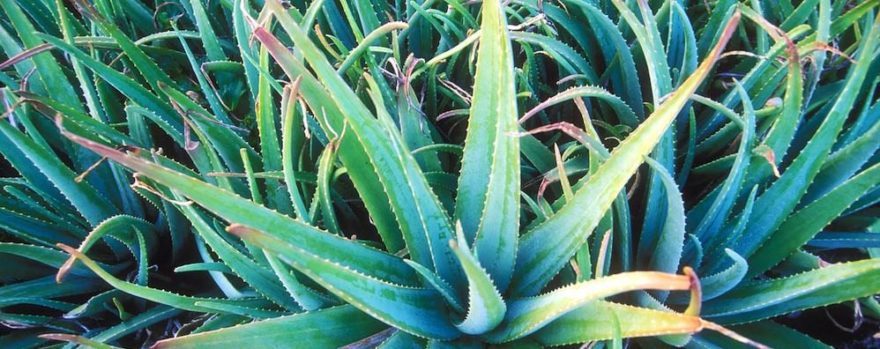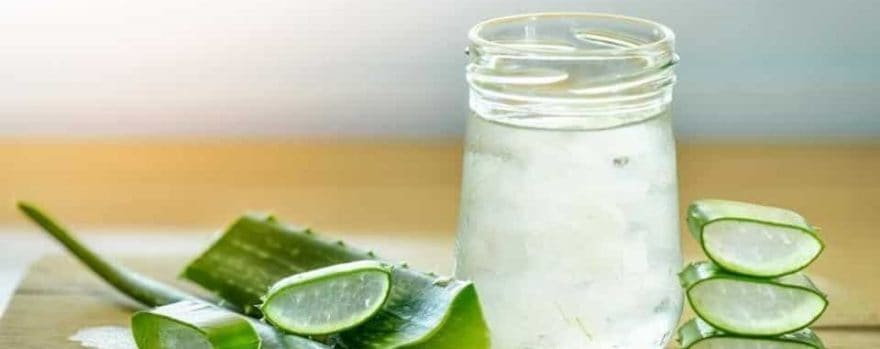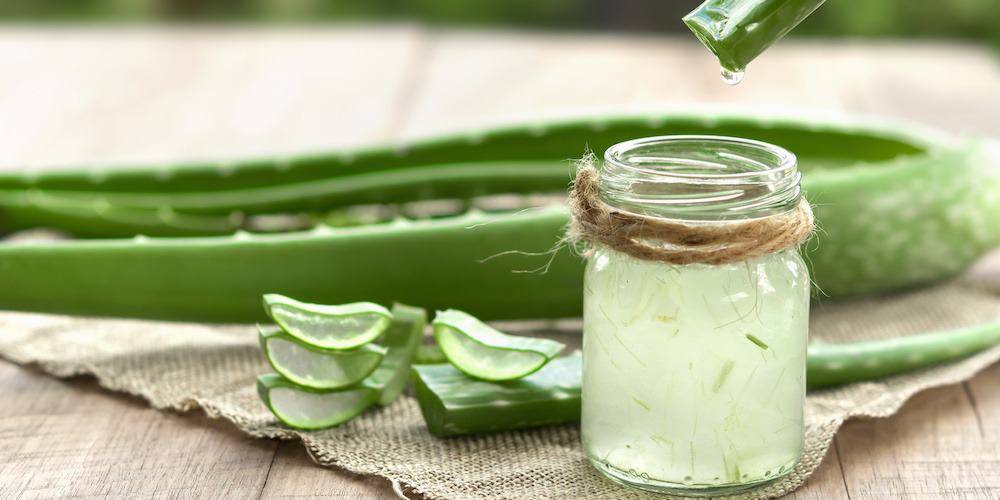VALIDATION SCIENTIFIQUE
Laure Fourchaud – 24.11.2021
Dr en physiologie de la nutrition
BIENFAITS DE L’ALOE VERA
✓ Améliore la digestion
✓ Participe au contrôle de la glycémie
✓ Alcalinisant
✓ Soulage la constipation
✓ Ultra-hydratant
✓ Soutient les défenses naturelles
What is Aloe Vera?
Aloe vera (Aloe barbadensis Miller) is a succulent plant, or fleshy plant, from the large family of liliaceae, along with lily, onion, or tulip. It is a so-called xerophytic plant, meaning it originally grows in arid environments with very little water. It is now found in tropical and warm temperate regions, thanks to its great adaptability.
Now cultivated in America, Africa, Europe, and Asia, it has existed for millennia in the Middle East, with its traces found in Mesopotamia as early as the 2nd millennium BC. It is also a potent remedy for treating wounds in Ancient Egypt, and it is adopted by traditional Chinese medicine and Ayurvedic medicine in India from the 10th century.

Aloe vera can reach up to 80 cm in height and features thorny green leaves, thick and fleshy, filled with water. The inside of the leaves consists first of a yellow liquid latex, then a thick and colorless gel, the mucilage (see diagram below). It is the latter that is used in medicine, cosmetics, and dietary supplements.

{{{TEMP_MARK_10}}}
Now, if aloe vera possesses all these virtues for external use, it’s because it is also an incredible source of nutrients and active compounds! And its low-calorie gel makes it a major dietary asset for those watching their weight.
{{{TEMP_MARK_17}}}
Nutritional Composition
- Proteins: 18 amino acids (including 7 essential: Isoleucine, leucine, lysine, methionine, phenylalanine, threonine, valine)
- Vitamins: A, B1, B2, B3, B6, B9, B12, C, E
- Minerals and trace elements: calcium, chlorine, chromium, copper, iron, magnesium, manganese, phosphorus, potassium, sodium, zinc
- Enzymes and unsaturated fatty acids
- Polysaccharides: glucomannan and acemannan

The Benefits of Aloe Vera
♻️ Improves Digestion and Rebalances the Intestinal Microbiota
Aloe vera contains several enzymes that facilitate digestion and regulate intestinal transit.
{{{TEMP_MARK_21}}}
It is particularly recommended for people suffering from irritable bowel syndrome and mild ulcerative colitis.
This study from the Baqiyatallah Research Center for Gastroenterology and Liver Disease in Tehran conducted on 33 people shows that the consumption of aloe vera for 8 weeks helps reduce pain and discomfort related to irritable bowel syndrome.
{{{TEMP_MARK_{{{TEMP_MARK_192}}}}}}
🍬 Participe au contrôle de la glycémie
Consumption of aloe vera is recommended for diabetes because it has hypoglycemic and anti-diabetic properties.
In Ayurvedic medicine, it is traditionally used in cases of diabetes for its hypoglycemic properties.
This review reports that 5 out of 7 studies show that the use of aloe vera gel helps reduce blood sugar levels in diabetic patients.
⚖️ Alkalizing
{{{TEMP_MARK_15}}}
🙏 Relieves constipation
{{{TEMP_MARK_1}}}
Its mucilage also helps increase the volume of water in the intestines.
{{{TEMP_MARK_11}}}
💎Ultra-moisturizing
{{{TEMP_MARK_18}}}
Also read 20 foods to protect and cleanse your liver
This hydration acts directly on the liver by supporting hepatic function and enabling better detoxification of the immune system. Its detoxifying and hydrating actions also promote our welfare.
{{{TEMP_MARK_61}}}
{{{TEMP_MARK_{{{TEMP_MARK_197}}}}}}
{{{TEMP_MARK_41}}}
🍑Cleanses and protects the skin
Its consumption has a cleansing and protective effect on the skin, thanks to the numerous antioxidants and vitamins it contains. It is a true ally for the beauty of the skin.
It notably helps in treating acne, protecting the skin from UV rays, and preventing its aging.

How to consume aloe vera?
Aloe vera in gel form
Note, we are discussing the gel directly extracted from fresh leaves, also known as mucilage, and not the often processed cosmetic gels for topical application.
{{{TEMP_MARK_13}}}
{{{TEMP_MARK_19}}}
The gel can easily be mixed into juices, smoothies or fresh vegetable soups. It is recommended not to consume it in a hot recipe to preserve its virtues as much as possible.

Aloe vera in juice form
Unless you make your juice from homemade gel, you can directly find aloe vera juices in organic stores, online shops, and in the dietary sections of supermarkets. The highest quality juices are made from the gel of fresh aloe vera leaves.
The pulp should be cold-stabilized to preserve its nutrients, without pasteurization or the addition of synthetic antioxidants. It is best to choose pure or highly concentrated ones, at least 90%.
{{{TEMP_MARK_31}}}
Also read The benefits of aloe vera juice
As the trend is towards healthy drinks, we find more and more aloe vera-based drinks in supermarkets. Unless otherwise stated, they are often made from plant extract powder and contain only a small percentage of it. In fact, these juices mainly consist of sugar and water, and therefore have little nutritional value.
If you don’t like its taste, you can also consume it as a dietary supplement in the form of capsules and tablets. There are also teas and herbal teas, but as their components are dry, they are less rich from a nutritional standpoint.
Taste of Aloe Vera
Aloe vera itself is rather bland or even bitter. However, its lack of flavor allows it to be easily mixed with other fruits and vegetables and give it the taste you want. Incorporate its juice into smoothies or gazpacho, and its diced mucilage into salads, for example. The latter is thickening and will give consistency to your sweet (coulis) or savory (fresh sauces) preparations.

Sustainable consumption: prioritize organic, fair-trade, and local aloe vera
✓ Of course, it is recommended to consume organic aloe vera, whether in gel, juice, or capsules. Organic labels ensure optimal quality of cultivation and production, without pesticide or heavy metal residues. It’s especially important to be careful with aloe vera as chemical fertilizers can end up in the gel. Most organic leaves come from Spain and South America.
✓ If buying aloe vera pulp or juice from emerging countries, look for fair-trade certifications to ensure better income for farmers and producers.
✓ Since 2016, it has been possible to find organic aloe vera cultivated in France! A former ethologist grows it in greenhouses in Brittany, in Pouldreuzic, and sells fresh leaves at the farm or online. A good way to reduce your carbon footprint and ensure product traceability.
Also read Organic Aloe Vera: Everything You Need to Know
Dosage
⌛️ The dosage of edible aloe vera depends on the desired effects. For a detox cure, seasonal changes are preferred, at the end of winter or summer, for example.
💧 In pure juice/gel: up to 50 ml per day
💊 In capsules: 200 to 300 mg per day
{{{TEMP_MARK_71}}}
{{{TEMP_MARK_12}}}
Internal use of this plant is not recommended in the following cases:
-
{{{TEMP_MARK_110}}}
- Abdominal pain
- Heart disorders
{{{TEMP_MARK_104}}}
{{{TEMP_MARK_{{{TEMP_MARK_176}}}}}}
{{{TEMP_MARK_102}}}
{{{TEMP_MARK_1{{{TEMP_MARK_192}}}}}}
The aloe vera gel and its hypoglycemic effect may interact with anti-diabetic medications, so medical advice should be sought before any cure.
When taken as a detox cure, the plant may cause diarrhea, a sign that the cleanse is working but that the doses should be reduced or stopped.
{{{TEMP_MARK_{{{TEMP_MARK_191}}}}}}
Aloe vera has been cultivated for millennia in the Middle East, North Africa, the Canary Islands, and Cape Verde. It is now also present in Europe, America, and Asia.
It originates from the Middle East: traces of it are found in Mesopotamia, where its skin and health benefits are mentioned as early as the 2nd millennium BC on clay tablets. Considered a plant of immortality, it is also a powerful remedy for healing wounds in Ancient Egypt, as indicated by the Papyrus Ebers, one of the oldest medical treatises.
{{{TEMP_MARK_16}}}
{{{TEMP_MARK_{{{TEMP_MARK_199}}}}}}
Its production and global trade are exponential. In 2015, aloe vera production reached 60,720 tons.
Detailed nutritional values of aloe vera
These data have been synthesized and verified for Darwin Nutrition by Laure Fourchaud, Doctor of Nutrition Physiology.
| Aloe Vera | {{{TEMP_MARK_105}}} | {{{TEMP_MARK_106}}} | /5g (1tsp) | {{{TEMP_MARK_107}}} |
| {{{TEMP_MARK_126}}} | {{{TEMP_MARK_152}}} | {{{TEMP_MARK_153}}} | {{{TEMP_MARK_153}}} | {{{TEMP_MARK_155}}} |
| {{{TEMP_MARK_136}}} | 1 | {{{TEMP_MARK_156}}} | {{{TEMP_MARK_157}}} | {{{TEMP_MARK_158}}} |
| {{{TEMP_MARK_{{{TEMP_MARK_192}}}0}}} | ||||
| Macronutrients | ||||
| {{{TEMP_MARK_130}}} | {{{TEMP_MARK_159}}} | {{{TEMP_MARK_160}}} | {{{TEMP_MARK_{{{TEMP_MARK_192}}}3}}} | {{{TEMP_MARK_{{{TEMP_MARK_192}}}4}}} |
| {{{TEMP_MARK_131}}} | {{{TEMP_MARK_161}}} | {{{TEMP_MARK_162}}} | {{{TEMP_MARK_{{{TEMP_MARK_192}}}5}}} | {{{TEMP_MARK_{{{TEMP_MARK_192}}}6}}} |
| {{{TEMP_MARK_127}}} | ||||
| {{{TEMP_MARK_133}}} | {{{TEMP_MARK_155}}} | {{{TEMP_MARK_{{{TEMP_MARK_192}}}7}}} | 0 | 0 |
| {{{TEMP_MARK_137}}} | ||||
| {{{TEMP_MARK_132}}} | {{{TEMP_MARK_176}}} | {{{TEMP_MARK_{{{TEMP_MARK_192}}}8}}} | {{{TEMP_MARK_164}}} | {{{TEMP_MARK_165}}} |
| {{{TEMP_MARK_139}}} | {{{TEMP_MARK_183}}} | {{{TEMP_MARK_183}}} | {{{TEMP_MARK_183}}} | {{{TEMP_MARK_183}}} |
| {{{TEMP_MARK_134}}} | {{{TEMP_MARK_183}}} | {{{TEMP_MARK_183}}} | {{{TEMP_MARK_183}}} | {{{TEMP_MARK_183}}} |
| {{{TEMP_MARK_121}}} | {{{TEMP_MARK_191}}} | {{{TEMP_MARK_166}}} | {{{TEMP_MARK_158}}} | {{{TEMP_MARK_168}}} |
| {{{TEMP_MARK_122}}} | {{{TEMP_MARK_177}}} | {{{TEMP_MARK_178}}} | {{{TEMP_MARK_1{{{TEMP_MARK_191}}}}}} | {{{TEMP_MARK_192}}} |
| {{{TEMP_MARK_128}}} | {{{TEMP_MARK_183}}} | {{{TEMP_MARK_183}}} | {{{TEMP_MARK_183}}} | {{{TEMP_MARK_183}}} |
| {{{TEMP_MARK_129}}} | {{{TEMP_MARK_179}}} | {{{TEMP_MARK_{{{TEMP_MARK_192}}}9}}} | {{{TEMP_MARK_{{{TEMP_MARK_192}}}9}}} | {{{TEMP_MARK_170}}} |
| {{{TEMP_MARK_1{{{TEMP_MARK_199}}}}}} | {{{TEMP_MARK_197}}} | {{{TEMP_MARK_168}}} | {{{TEMP_MARK_172}}} | {{{TEMP_MARK_151}}} |
| {{{TEMP_MARK_{{{TEMP_MARK_192}}}1}}} | ||||
| {{{TEMP_MARK_138}}} | {{{TEMP_MARK_173}}} | {{{TEMP_MARK_180}}} | {{{TEMP_MARK_174}}} | {{{TEMP_MARK_175}}} |
| Vitamins | ||||
| {{{TEMP_MARK_1{{{TEMP_MARK_197}}}}}} | ||||
| {{{TEMP_MARK_124}}} | ||||
| {{{TEMP_MARK_125}}} | {{{TEMP_MARK_198}}} | {{{TEMP_MARK_181}}} | {{{TEMP_MARK_182}}} | {{{TEMP_MARK_199}}} |
| {{{TEMP_MARK_115}}} | ||||
| {{{TEMP_MARK_116}}} | ||||
| {{{TEMP_MARK_117}}} | ||||
| {{{TEMP_MARK_100}}} | ||||
| {{{TEMP_MARK_118}}} | {{{TEMP_MARK_183}}} | {{{TEMP_MARK_183}}} | {{{TEMP_MARK_183}}} | {{{TEMP_MARK_183}}} |
| {{{TEMP_MARK_119}}} | ||||
| Vitamin B9 or folate (µg) | ||||
| {{{TEMP_MARK_111}}} | ||||
| {{{TEMP_MARK_120}}} | {{{TEMP_MARK_183}}} | {{{TEMP_MARK_183}}} | {{{TEMP_MARK_183}}} | {{{TEMP_MARK_183}}} |
*%RI: % Reference intake for an adult
Antioxidant compounds: phenolic acids (anthraquinones): aloin and emodin
{{{TEMP_MARK_101}}}
- Mucopolysaccharides (acemannan)
- Hormones: auxin and gibberellin
{{{TEMP_MARK_112}}}
{{{TEMP_MARK_{{{TEMP_MARK_198}}}}}}
Sources and scientific studies
Hossein Khedmat, Ashraf Karbasi, Mohsen Amini, Aghdas Aghaei, and Saeed Taheri, 2013. Aloe vera in treatment of refractory irritable bowel syndrome: Trial on Iranian patients.
L. Langmead, R. M. Feakins, S. Goldthorpe, H.Holt, E. Tsironi, A. De Silva, D. P. Jewell & D.S.Rampton 2004. Randomized, double-blind, placebo-controlled trial of oral aloe vera gelfor active ulcerative colitis.
Ngo MQ, Nguyen NN, Shah SA, 2010. Oral aloe vera for treatment of diabetes mellitus and dyslipidemia.
Añibarro-Ortega et al, Compositional Features and Bioactive Properties of Aloe vera Leaf (Fillet, Mucilage, and Rind) and Flower, 2019
{{{TEMP_MARK_51}}}
Marshall JM. Aloe vera gel: What is the evidence? Pharma Jr. 1990 ; 24 : 360–2.
Shelton M. Aloe vera, its chemical and therapeutic properties. Int J Dermatol. 1991 ; 30 : 679–83.



